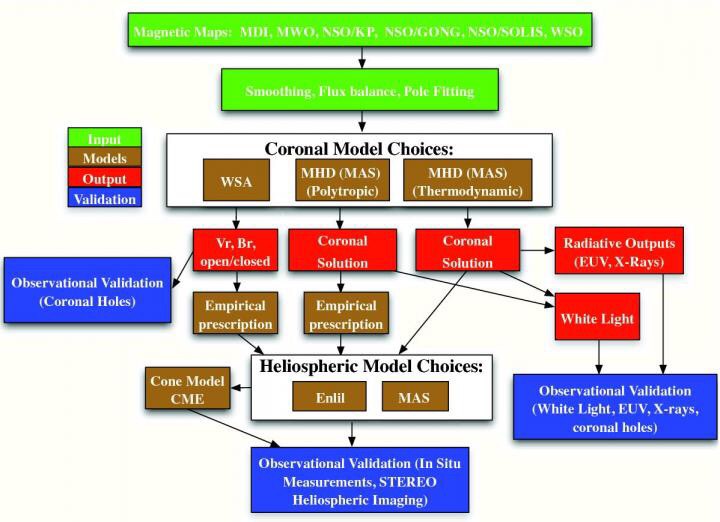Comparative analyses of current three-dimensional numerical solar wind models

Space Weather research programs began around the world in the 1990's. Presently, three larger research groups are modeling key portions of the solar-terrestrial environment (i.e. solar wind). These groups are (i) Center for Integrated Space Weather Modeling (CISM) at Boston University (ii) the Center for Space Environment Modeling (CSEM) at the University of Michigan and (iii) the Solar-Interplanetary-Geomagnetic (SIGMA) group of the State Key Laboratory at the Chinese Academy of Sciences. The models developed by the three group are summarized as follows:
A. Combination of kinematic and numerical model: Corona-Heliosphere (CORHEL) model
Workers at the CISM of Boston University have assembled a number of current models for space weather prediction formalism (Goodrich et al. 2004) based on the physics of each region. A flow chart of the key components of corona-heliosphere models (CORHEL) is given in Fig. 1.
B. Self-Consistent magnetohydrodynamic models
There are two groups using this framework, the CSEM at the University of Michigan and the SIGMA at Chinese Academy of Sciences (CAS). Methods used by these two groups are described in the following sections.
B.1. SWMF (Space Weather Modeling Framework) BATS-R-US code
The CSEM at the University of Michigan has developed the SWMF that provides a high-performance flexible frame-work for physics-based space weather simulation model. The SWMF integrates numerical models of the Eruptive Event Generator (EE), Lower Corona (LC), Solar Corona (SC), Inner Heliosphere (IH), Outer Heliosphere (OH), Solar Energetic Particles (SEP), Global Magnetosphere (GM), Inner Magnetosphere (IM), Radiation Belt (RB), Polar Wind (PW), Ionosphere Electrodynamics (IE) and Upper Atmosphere (UA) into a high-performance coupled model (Toth et al. 2012).
B.2. SWIM (Space Weather Integrated Model: SIP-CESE-MHD Code
The SIGMA weather group at the Key Laboratory for Space Weather of the CAS has developed the SWIM system. This system is different from the other two systems because it constitutes one uniform numerical system from the solar surface to Earth's environment (1AU) and beyond. In this sense, there is no interface between different regions. This methodology could improve the numerical efficiency and accuracy. The numerical code for SWIM is based on the space time conservation element and solution element (CESE) method. The SWIM system is a framework for integrating and running various space weather models. It provides researchers an uniform environment to integrate the models of different spatial regions into a workflow that prepare the observational data and then analyzes and visualizes the output of the models. SWIM is programmed by using a combination of languages: C, FORTRAN and Python. SWIM is modularized into 4 layers: application layer (AL), Execution layer (EL), Calculation Layer (CL), and Foundation layer (FL).

 How to resolve AdBlock issue?
How to resolve AdBlock issue?